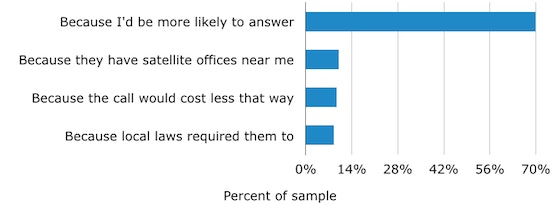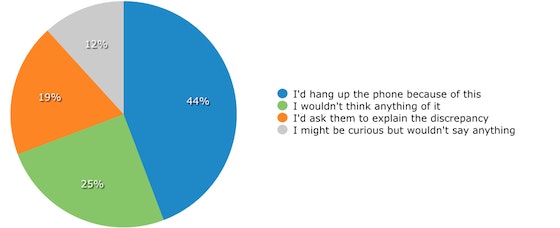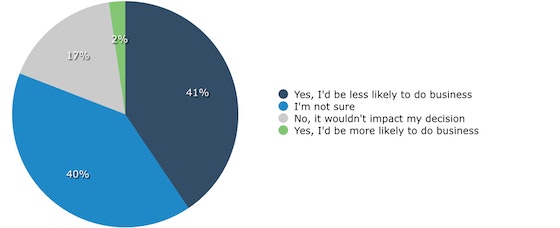Survey: Local Presence Dialing—Foot in the Door, or Door-Slammer?
Local presence dialing is the practice of making it seem as though a call is coming from a local area code, even when it isn’t. (Note that this differs from caller ID spoofing). It’s available through many telephony platforms and has found favor with many call centers—especially those engaged in outbound sales.
The idea is that people are more apt to answer a call from an unknown number if that call appears to be coming from a local number: this gets the caller’s “foot in the door.” But is answering enough? Does local presence dialing really open doors for outbound-sales calls, or does it only slam them shut? We conducted a survey to find out.
People Four Times More Likely to Answer for Local Numbers
We began our survey by testing responses to three different scenarios. In all three, we asked participants the likelihood that they would answer a call if they did not recognize the number on the caller ID.
Likelihood of Answering Unknown Call

The results are quite clear: People are nearly four times more likely to answer calls from local numbers. Only 7 percent said they’re likely to answer a call from an unknown caller with a toll-free area code—but that number leaps to 27.5 percent when the unknown caller is using a local area code.
These differences became even starker when we examined each scenario individually:
Lowest Answer Rate for Toll-free Area Codes
When people see a toll-free area code on caller ID, they can be certain it’s a business calling. If it’s an “unknown number”—meaning, a business the person doesn’t have a pre-existing relationship with—they often prefer not to answer the call. In fact, just over 80 percent said they’d be “extremely unlikely” to answer the call.
Slightly Higher Answer Rate for Out-of-state Area Codes
Calls from out-of-state area codes are, by definition, not local—but it’s not a given that they’re business numbers, either. Those who said they were either “somewhat” or “extremely likely” to answer an unknown call from an out-of-state area code totaled 13 percent—nearly doubling the 7 percent for the previous question.
The portion who said they’d be “extremely unlikely” to answer also dropped marginally, to 75 percent. It’s clear that people are more willing to answer unknown out-of-state calls than unknown toll-free calls.
Highest Answer Rate for Local Area Codes
Now, the real question: Do people respond differently when the unknown caller appears to be calling from a local area code? Twenty-eight percent of those polled said they were either “somewhat” or “extremely likely” to answer calls from unknown callers with local area codes.
This is a rate twice what we found for out-of-state area codes, and almost four times what we found for toll-free area codes. And the percentage that are “extremely unlikely” to answer dropped to 53 percent—down from 80 percent with toll-free area codes, and 75 percent with out-of-state area codes.
As a strategy for getting people to answer the phone, local presence dialing is clearly extremely effective.
Mixed Responses to Local Presence Dialing
The above results prompt several questions, the first being: When a person notices a discrepancy between what caller ID displays and the presumed location of the caller, what conclusions will that person draw? To find out, we asked our participants what assumptions they make about the company’s motivations for using a local area code.
Suspected Reasons Out-of-State Companies Use Local Area Codes

The goal of local presence dialing is to get more people to answer the calls, and the results we presented above show that it is effective. They also show that people understand the motivations behind the use of local presence dialing: Seventy percent stated that the reason a business would alter its displayed caller ID is to increase the chance they’ll answer.
They’re right, of course—and this suggests that the practice may now be commonplace enough that people expect it.
Nearly Half Would Hang Up on Local Presence Dialers
Local presence dialing does increase the rate at which people answer calls from unrecognized callers. And once they realize that the caller is not local, most people know the reason the caller used a local caller ID.
How, then, does this affect the relationship moving forward? We asked how people would react if they answered a call from a company using a local area code, but found the company was actually out-of-state.
Reaction to Answering Out-of-State Calls From Local Numbers

These responses are very polarized. Just over half said they’d either ask about the discrepancy, not care or be only “curious” about it. Meanwhile, just under half said they’d hang up the phone because of it.
Given that these were anonymous responses to an online survey, it’s prudent to take them with a grain of salt. It’s possible that in real life people would not be so quick to hang up the phone. Nevertheless, this does serve as a strong indication. It at least tells us how people feel they’d react, even if in reality, their reactions might be a little less severe.
Respondents Divided on Reaction to Local Presence Dialing
Local presence dialing is just the first link in a chain: one that begins with a phone call and ends, ideally, with some form of business transaction. With the above questions, we’ve seen how answer rates can be improved with local presence dialing, as well as what people think and feel about the practice. But how does all of this influence the last link in the chain? Does local presence dialing affect business outcomes?
Impact of Local Presence Dialing on Likelihood to Do Business

What we see here is a large portion of respondents claiming local presence dialing would negatively affect their likelihood to do business with the caller. Interestingly, though, we see an equally large portion on the fence.
It seems likely that those expressing a neutral opinion, saying they’re “not sure” if their decision to do business would be affected, would base their decision on other factors, such as the content of the call, the sales pitch or the attractiveness of the deal or business proposal.
Conclusions
This survey has revealed several important lessons regarding the practice of local presence dialing. The first is that it clearly works. People are far more likely to answer calls from unknown callers if they see a local number on caller ID: four times more likely than if the caller ID displays a toll-free number.
However, once people realize the caller’s actual locale, they’re generally savvy enough to understand the reason for the discrepancy. The strategy does have a small element of deception, though, and a large portion of respondents claim they’d react strongly to this (by hanging up the phone). It’s uncertain whether or not, in reality, people would react as strongly as they claim.
The most significant findings are, first, that local presence dialing could negatively affect the chances that a person will want to do business with the caller. This indicates that the practice should be used with caution.
The second is that there’s an equally large group indicating they’re unsure if it would impact their decision. This uncertainty means that in these cases, local presence dialing does work to get the caller’s foot in the door.
Given that local presence dialing can increase the answer rate by several hundred percent, the 41 percent who claim they’d hang up can, in a statistical sense, be written off as a loss. That number of slammed doors is more than made up for by the increased rate at which others are opened. Discounting other factors, such as the company’s reputation or broader public relations strategies, local presence dialing can be very effective.
Methodology
To find the data in this report, we conducted a four-day online survey of six questions, and gathered 2,310 responses from randomly selected Internet users within the United States. We worded the questions to ensure that each respondent fully understood their meaning and the topic at hand.
Sources attributed and products referenced in this article may or may not represent partner vendors of Software Advice, but vendor status is never used as a basis for selection. To further discuss this report, or obtain access to any of the charts above, feel free to contact me at craig@softwareadvice.com.